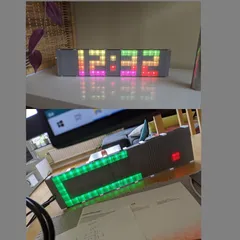E-ink digital photo frame
Description
PDFThis is a small wifi powered photo frame that runs on battery (for a long time). For showing the photos, it uses a three color (black, white, red) 2.13" e-ink display with a resolution of 104x212 pixels.
The e-ink display only need power when updating the photo, which mean that the photo frame is running in deep sleep most of the time. It works as follows:
- Wakes up every 3.1 hours, or when touching a small hidden touch pin on the side of the frame (can be seen in one of the photos).
- Enables WiFi and connects to a local server that hosts the photo to show.
- Downloads the photo (two bitmaps, one with the pixels that should be drawn with black, and one with pixels that should be drawn in red).
- Draw the image (first black, then red).
- Go back to deep sleep.
This is how a drawing looks like. Updating the display is quite slow which is a characteristics of the e-ink/ePaper display. You can see that it first draw black followed by red. This is in real time:

Design wise, there is not much happening. The box is sized to fit the 2.13" e-ink, a LiPo 3.7V 3000mAh battery, the ESP-32-S2 mini and a DC-DC step up converter.
Server side, there is a bunch of stuff happening.
Parodically (a couple of times a month), a index of all my Google Photo are downloaded. Not the photos themselves, but just the index. When the photo frame is requesting a photo (using http), in short this is what is happening:
- A random photo is picked from the index, and downloaded.
- The downloaded photo is resized and the colors are remapped to white, black and red (using that palette).
- Then two different bitmaps are extracted, one for only the black pixels, and one for only the red ones. Step 2 and 3 are using imagemagick.
- Each bitmap is then converted into bitmap format that the e-ink library understands.
- These are then packaged in one payload that the esp-32 receives.
- The esp-32 draws each bitmap, first black then red, and then go back to sleep.
I will upload all the source code! There are a bunch of different things and scripts going on to make all of this work. I need to document and format them a bit first, so stay tuned.
Tags
Model origin
The author marked this model as their own original creation.




